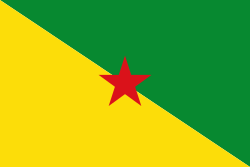 | |
| Use | National flag |
|---|---|
| Proportion | 2:3 |
| Design | A vertical tricolour of dark blue, white, and red |
 | |
| Use | Commonly used but not official flag of French Guiana |
| Proportion | 2:3 |
| Design | Divides diagonally with green in the upper fly and yellow in the lower hoist and bears a red five pointed star in the center. |

French Guiana has no official flag, with the national French flag used when a flag is needed to represent it either as an overseas region or an department of France.
Contents
A widely used unofficial flag consists of two triangles, colored green in the upper fly and yellow lower hoist, with a red star in the centre. Green would represent forests, yellow represents minerals such as gold, while the red star represents either blood or socialism.
The unofficial flag was originally designed in 1967 by the Guyana Agricultural and General Workers' Union. It would be a topic of discussion at the Guyanese Social Forum two times and would eventually be adopted by the Departmental Council of French Guiana, though it would remain unofficial. The design would also be used by the French Guiana national football team.




